Student Resource: study ideas, questions and activities (pdf)
The leader and main figurehead of the suffragist movement in New Zealand – the first country in the world to grant universal adult suffrage to men and women equally. Kate was a source of inspiration to suffragists and campaigners for equality between the sexes, both in New Zealand and throughout the world.
Before embarking on the Kate Sheppard story it is pertinent to reflect that just over half of the Western world has only had the right to participate in the political processes of society for just over a century, beginning with New Zealand, most countries less. That, when most of the great philosophical treatises, from Plato until the last one or two hundred years, refer to the rights of ‘man’ they mean specifically just that, men, not women or children. The biological theory of equilibrium asserts that change in a species occurs at the fringes, a place where theses are tested and upset. That it took a woman from a distant colonial outpost to make the first domino fall, rectifying what a century of struggle has proved to be an absurd and arbitrary exclusion, is a story of the edge.
Sheppard proved to be an ideal catalyst, a woman without sectarian narrowness and characterised by judgement, tolerance and charm. A natural leader, she argued for suffrage at public meetings and in her own persuasive writings. On limited means she organised pamplets, letters to the press, talks, petitions and personal contacts with politicians. Writing in The Prohibitionist, she kept women up to date not only in the New Zealand suffrage movement, but also those in other countries.
The arguments of the Enlightenment philosophers envisaged individual political rights for ‘men’, but their reasoning could easily be extended to women. For suffragists like Sheppard the task was one of conviction and inspiration. The cogency of her ideas and the winning elegance of her style is demonstrated in this extract from the 1888 pamphlet “Ten Reasons Why the Women of N.Z. Should Vote”:
“Because it has not yet been proved that the intelligence of women is only equal to that of children, nor that their intelligence is on a par with that of lunatics or criminals.”
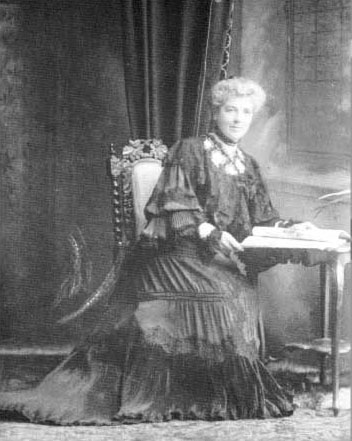
Kate Sheppard photographed in London, 1904 Canterbury Museum.
Early Edification
Catherine Wilson Malcolm, who adopted the names Kate or Katherine, was born to Scottish parents in Liverpool in 1847. From her early childhood years she was distinguished for her intellect and her religious convictions: luckily, for a woman of the times, she received a good education, and thorough religious edification from an uncle who was a Minister of the Free Church of Scotland.
Kate’s father died in 1862 and her mother brought her and her two brothers and sisters to New Zealand in 1868. The family settled in Christchurch and in 1871 Kate married Christchurch merchant Walter Allen Sheppard. The couple had one son Douglas, born in 1880.
A New World and a New Order
Early in her married life, Sheppard was active in the church and in the temperance movement. At the same time the social climate in New Zealand was maturing in terms of gender balance, urbanisation and industrialisation. While trade, political and economic links with Britain were being tightened by the reigns of recolonisation (as Jamie Belich argues in Paradise Reforged), some moods in the colony were changing towards a feeling of independence from the mother country. There was a sentiment of being part of a new, more egalitarian world, more like the United States than the Europe most settlers had left.
In this ‘frontier’ climate, with looser shackles of class and caste than in the older European countries, ideals of feminism began to grow. In 1869 the writer “Femina” (a pseudonym for Mary Ann Müller) wrote “An appeal to the men of New Zealand”, calling for the vote for women. In 1871 writer and speaker “Polly Plum” (Mary Colclough) gave a lively lecture on the rights of women to vote. By the end of the 1870’s the women’s suffrage movement was well-established in New Zealand. It drew attention from overseas suffragists, notably the liberal philosopher John Stuart Mill who was a strong supporter of the British suffrage movement. In 1869 Mill, a champion of individual freedom, had published an influential essay ‘On the subjugation of women’, arguing the feminist case in terms of liberal individualism. Its impact was immediate and profound, not only in Britain, but in America, Australia and New Zealand. Mill wrote to Müller in 1870, sending her a copy of his book and congratulating her on the ‘excellent beginning’ of the women’s suffrage movement in New Zealand. However despite the positive start and increasing social equality, attempts in the late 1870’s and early 1880’s to introduce Women’s Franchise Bills into parliament were overturned.
The depression of the 1880’s in New Zealand led to an increase in social misery and unrest; problems associated with the Old World – poverty, sexual license and disorder began to become more common. For many women the immediate cause was seen to be dependence on alcohol, and they welcomed a women’s organisation that sought to ban it.
Sheppard, long a temperance supporter and early feminist, was one of the founding members, in 1885, of the New Zealand Women’s Christian Temperance Union. In 1887, when franchises of the Union were set up around the country, Sheppard was elected the national superintendent of the franchise.

‘White Ribbon Digest’ – magazine and international symbol of the WCTU (the first women’s organisation in the world).
An Advanced Political Leader
One of the early arguments for women’s suffrage was that women were more likely to support prohibition and other measures that might improve the welfare of women and children. It was seen largely as a tool of moral reform. This drew on the popular 19th century conception of women as being more highly principled than men. This conception, drawing on the ‘natural’ dignity of women, was used as justification for denying women the vote:
“Women’s mission upon earth is to drag men up to heaven, which everyone will admit to be a rather heavy job. Therefore I do not believe we should clip their wings when striving in that direction, by dragging them down into the political arena …”
The writings and speeches of Kate Sheppard show a broader and more modern appreciation of feminism. Sheppard advocated equality between the partners in marriage and argued for women to be able to play a full role in society, one befitting the expression of their talents and abilities. She lived out her convictions that women should play an active life, being one of the first female cyclists in Christchurch. At a time when some ‘scientific’ theories advocated that women should avoid vigorous physical activity, especially cycling, because their bone structures and dispositions were too fragile to cope, Sheppard was an example of common-sense. She was very disparaging of women who sat around and looked delicate and empathised with those who were ‘hearty and hale’.
Sheppard expressed her interests in a broad range of issues affecting women, the advantages of contraception, the rights of divorce, the equal rights to guardianship of children, and clothing that did not crush internal organs. It wasn’t a stretch for her to see that the corset was certainly more of a threat to women than the cycle, and she was a determined advocate of the abolishment of such restrictive devices. She argued for girls to have as much chance as boys did to run and play freely.
In Sheppard, the Women’s Christian Temperance Union had found a leader who was both intellectually able and persuasive. She was a talented writer and public speaker: “Hers was a quietly determined, persuasive and disarmingly feminine voice”, Tessa Malcolm writes in her essay on Sheppard in The Dictionary of New Zealand Biography.
The Long March Towards Suffrage?
Sheppard also possessed the tact and perseverance necessary to see the long struggle through to its eventual success. This required lobbying sympathetic politicians, preparing pamphlets, editing and writing a women’s page in the national temperance newspaper The Prohibitionist and organising petitions to be presented to Parliament.
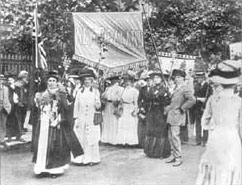
Suffragette city: New Zealand supporters of the British women’s suffrage campaign march in London, 1910 Auckland Institute and Museum Library.
The first petition, in 1891, attracted 9,000 women’s signatures and the second, in the following year, 19,000 signatures. The third and final petition, in 1893, was signed by almost 32,000 women, estimated at up to a third of the adult female population at the time. It was then the largest petition ever presented to Parliament.
The tide of public opinion towards suffrage had turned strongly in its favour, largely thanks to the campaigning of the WCTU across the country. Then they suffered a setback: John Ballance, the Liberal Party leader and premier, and one of Sheppard’s most important political allies, died in April 1893. He was succeeded in the premiership by Richard John “King Dick” Seddon, who was fiercely opposed to the suffragists and their cause.
The success of the suffrage petitions had spread panic in the ranks of the liquor lobby, which had responded by promoting anti-suffrage petitions in public houses. In Dunedin, Henry Fish, the representative of the liquor trade in Dunedin and in Parliament, and described as ‘simplistic and boorish’, paid anti-suffrage campaigners according to the number of signatures that they obtained. He was said to have collected 5000 names, but his credibility was seriously damaged when some of the names proved to be fraudulent, and that some women who had signed were misled into thinking they were voting for women’s suffrage.
Though there was steady support for the women’s cause from Liberal backbenchers, the attitude of the minister’s was more dubious. Even those who were ostensibly in support of suffrage held diverse views about the role that women should play in society. Would voting rights challenge the husband’s manliness? Would reform lead to unthinkable role reversals where the wife brought home the bacon and the husband wore the apron? Would giving women the vote mean the end of the sale of alcoholic beverages? Some believed women were a radical force that threatened the natural order of society, others that they were the bastion of moral integrity.
Amongst other objections was the concern that women would abandon their families; that voting was somehow not feminine; that the finances of the colony would be adversely affected and New Zealand’s credit in London would be shattered; and that women were overly emotional creatures and politics was no place for excessive emotion! A more telling objection came from the Maori member Mr. Wi Pere, who was greatly concerned about the distraction women would pose in Parliament:
Satirical view of alcohol prohibition and suffrage.
“Although I am getting up in years I must confess I should be affected by a weakness of that sort. If the honourable gentlemen in charge of the Bill would introduce a clause providing that only plain women should be allowed to come into the House, I think the source of danger would be removed, but if any beautiful ladies were sent to this House I am sure they would lead astray the tender hearts of some honourable gentlemen, particularly the elder members of the House. I say in conclusion that if attractive ladies are allowed into this House I am quite certain that my own wife will never consent to my returning here.”
He needn’t have worried, as it was to be over fifty years before the first woman would enter Parliament. Still suffrage was a pressing issue that cut across traditional lines of allegiance and required deft political manoeuvring in furthering its cause.
Success … Eventually
A Women’s Suffrage Bill was introduced to Parliament by Sheppard’s political ally, John Hall in June 1893, but superseded by the Electoral Bill which was introduced by Seddon and which contained a clause on women’s suffrage. Seddon had had no choice but to introduce the bill, as his Government had already pledged its support, but worked against its passage behind the scenes. Initially he let the bill pass through the lower house in the expectation that the Legislative Council (or the ‘upper house’ – at the time the New Zealand parliamentary system was divided into two houses) would negate the vote by the lower house. Women would have had to wait much longer for the vote if King Dick’s plans had been successful, but by the time for the third reading of the bill, Seddon realised that opposition and support for the bill was nearly evenly divided among members of the Legislative Council. Believing that he only needed one more vote against to defeat the bill, Seddon sent a telegraph to one member telling him to change his vote to opposition.
Unfortunately for Seddon, news of his scheme got out and two members who had hitherto voted against the bill, changed their votes and voted in favour, in part because they were incensed by Seddon’s manoeuvring. The final total was 20 votes in favour to 18 against and the bill was passed on 19 September 1893.
The Electoral Act granted universal suffrage to New Zealanders, making it the first country in the world to grant full voting rights to women. Congratulations poured in from suffrage movements all over the world, inspired by this success in a country that was seen as a distant and small colonial outpost.
New Zealand’s victory would predate that of her larger allies by decades: British women were not granted suffrage until 1918 and American women were not granted it across the whole country until 1920.
The Next Stage: Consolidating the Victory
For Sheppard and the WCTU, the next phase of the campaign was to begin. The Union set about enrolling as many women as they could in time for the General Election which was to be held in eight weeks time. With many voters isolated, with miles of rugged terrain between cities, Sheppard and the WCTU were determined to let these woman know they could flex their electoral muscle. At the 1893 elections it is estimated that 65% of all eligible New Zealand women voted.
Sheppard went to Britain on a speaking tour and was asked by the International Council of Women to form a New Zealand chapter of the organisation. She was in hot demand in Britain as a guest speaker to those women and campaigners struggling to get the franchise for themselves. They were curious to discover the secret to New Zealand’s success, how a world-changing precedent had come from the edge of the world. Sheppard was pragmatic in response, expressing the opinion that her campaigners had succeeded through years of tireless and unmitigated work, and because of New Zealand’s colonial beginnings – it was a kind of ‘political experiment’.
She was elected president of the National Council of Women (NZ) in 1896 and served in that role for the next three years. The NCW published its own magazine at first called the ‘NCWNZ Bulletin’ and now ‘The Circular’, which was entirely written and run by women, then the only New Zealand paper to do so. It also held an annual conference debating political issues and issues of relevance to women’s equality, which was widely reported in newspapers and so high in prominence that it was often referred to as the Women’s Parliament. In reply, Sheppard wrote with pointed understatement:
“In Wellington is every year assembled a National Council of men, which holds a session lasting several months… From that Council women are excluded… Under these circumstances a National Council which largely represents the thinking and working women of the colony (and which, it may be remarked, costs the country nothing) becomes a necessity. I trust the day is not far distant when the necessity for men’s councils and women’s councils, as such, will be swept away.”
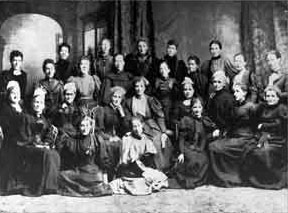
The National Council of Women, Christchurch, 1896. Kate Sheppard (president) sits centre. Permission of the Alexander Turnbull Library, National Library of New Zealand, Te Puna Matauranga o Aotearoa, must be obtained before any re-use of this image.
An Elder Stateswoman
Sheppard continued to write and publish widely, influencing a rising generation with her forceful and liberal writings. By the beginning of the 20th century, however, she was in failing health. Attempts at a cure failed and in 1903, Sheppard resigned from the presidency of the NCW. Ill-health also made it necessary for her to decline the office of franchise superintendent of the World’s WCTU. She was elected honorary vice president of the International Council of Women in Toronto in 1909, but was not well enough to attend the conference.
Sheppard’s only child Douglas died in 1910, shortly after his marriage, and her husband Walter died in 1915. In 1925 at the age of 78, Sheppard married again to William Sidney Lovell-Smith, who died four years later. Sheppard’s only grandchild Margaret died in 1930.
Kate Sheppard Lovell-Smith died in Christchurch on 13th July 1934. She is buried in Addington Cemetery, next to her mother, brother and one sister. Today her image graces the New Zealand $10 note and a mural commemorating the achievements of the suffragists stands on the banks of the Avon River in Christchurch. In her obituary in the Christchurch Times on 16 July 1934, it was written:
“A great woman has gone, whose name will remain an inspiration to the daughters of New Zealand while our history endures.”
History is shaped by more than just individuals, it is moved by classes, groups, patterns, urges and forces, sometimes beyond control and comprehension. The campaign to give women the vote achieved a right that seems ‘natural’ today but the change required tireless effort and conviction from thousands of campaigners, often in the context of antipathy and resistance as well as opportunity. As Sheppard forcefully writes,
“We are tired of having a ‘sphere’ doled out to us, and of being told that anything outside that sphere is ‘unwomanly’. We want to be natural just for a change … we must be ourselves at all risks.”
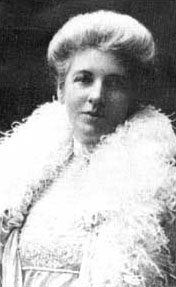
“Risk, risk anything”, 1913 Canterbury Museum
Movements draw upon heroes and stories for motivation and impetus and while the campaign for women’s right to vote was not a one-woman operation, the personal contribution of Kate Sheppard cannot be too heavily stressed. Her contribution to New Zealand becoming the first country to grant voting rights to women is etched in history. The poet Jessie Mackay, who knew Kate well, described her as, “the woman whose life and personality made the deepest mark upon New Zealand history.”
In 1919 women were granted the right to stand for Parliament, possibly influenced by the role they played in the war effort, and in 1934, just before her death Sheppard had the satisfaction of seeing the first woman MP enter Parliament.
Postscript:
It is a little known fact that New Zealand was also the first country to give voting rights to the indigenous population without a property qualification. Voters a century and a half ago had to own property to be eligible to vote. Maori usually didn’t own property individually, and governments of the day wished to bring Maori into the new parliamentary system after the mid 1800’s. Therefore all Maori men over the age of 21 actually got the vote in New Zealand some ten years before the franchise was extended to all ‘white’ men over that age, with the qualification that Maori were able to vote only for their own members of Parliament. At least one suggestion that Maori be allowed to vote for Pakeha members of Parliament was quickly discarded – it is pertinent to note that at the time (mid 1800’s) the Maori population exceeded the Pakeha population.
References:
If you’d like to find out more about Kate Sheppard, you could look at:
McLauchlan, Gordon. (1995) “The Bateman New Zealand Encyclopedia“, 4th edition, David Bateman Ltd, Auckland, NZ.
Malcolm, Tessa K. (1993) “The New Zealand Dictionary of Biography” Volume Two, Department of Internal Affairs, NZ.
Boon, Kevin. (1993) “Kate Sheppard Famous New Zealand Women“, Kotuku Publishing, Wellington, NZ.
Orange, Claudia (editor). (1993) “The Suffragists – Women Who Worked for the Vote“, Dictionary of New Zealand Biography, South Wind Production Pte, Ltd, Singapore.
Devaliant, Judith. (1992) “A Biography of Kate Sheppard“, Penguin Books (NZ) Ltd, Auckland, NZ.
Lovell-Smith, Margaret (selected by). (1992) “The Woman Question – Writing by the Women Who Won the Vote“, New Women’s Press Ltd, Auckland, NZ.
Or you can look at the websites:
NZine Women’s Suffrage:
http://www.nzine.co.nz/suffrage.html
[Accessed May 2000]
NZHistory.net.nz:
http://www.nzhistory.net.nz/Gallery/Suffragists/Suffragists.htm
[Accessed May 2000]
Biographies of Kate Sheppard:
http://www.loadstar.prometeus.net/zealand/
http://209.52.189.2/article.cfm/new_zealand_history/29392
[Accessed May 2000]
For information about the New Zealand suffrage movement in general and its influence on the worldwide suffrage movement, you can look at:
NZHistory.net.nz:
http://www.nzhistory.net.nz/Gallery/Suffragists/SuffIntro.htm
[Access May 2000]
National Archives Suffrage Petition:
http://www.archives.govt.nz/holdings/petition_frame.html
[Accessed May 2000]







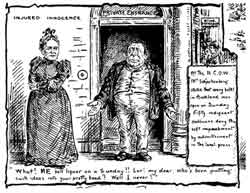






I´m a half New Zealander, half American but Ilived in NZ until I was 4, then I moved to Thailand. I'm using this for NHD!
This has been a very informative article. I'm currently writing an essay on Kate Sheppard and I haven't been able to find much information, until now.
I am 13 years old and I'm doing a speech on kate Sheppard and this is really gonna help me with my research
I am 13 and I am doing a social studies project on Kate sheppard
I am 12 years old and I am doing a study on Kate Shepard and I thought that your article was great because it helped me a lot. From Emily Student, New Zealand.
Well put together. Thank you for this.
I am 12 years old and I am doing a study on Kate Shepard and I thorght that your article was great because it helped me a lot. From Emily Student, New Zealand
I was looking at an American 'World History' of famous women, and specifically the suffrage movement, and passed on NZEdge's write-up on Kate Sheppard. I sometimes get the feeling that America's view of world history does not stretch as far as NZ, does anyone else get that impression? See http://www.umkc.edu/imc/suffrage.htm Bilingual Receptionist London, UK